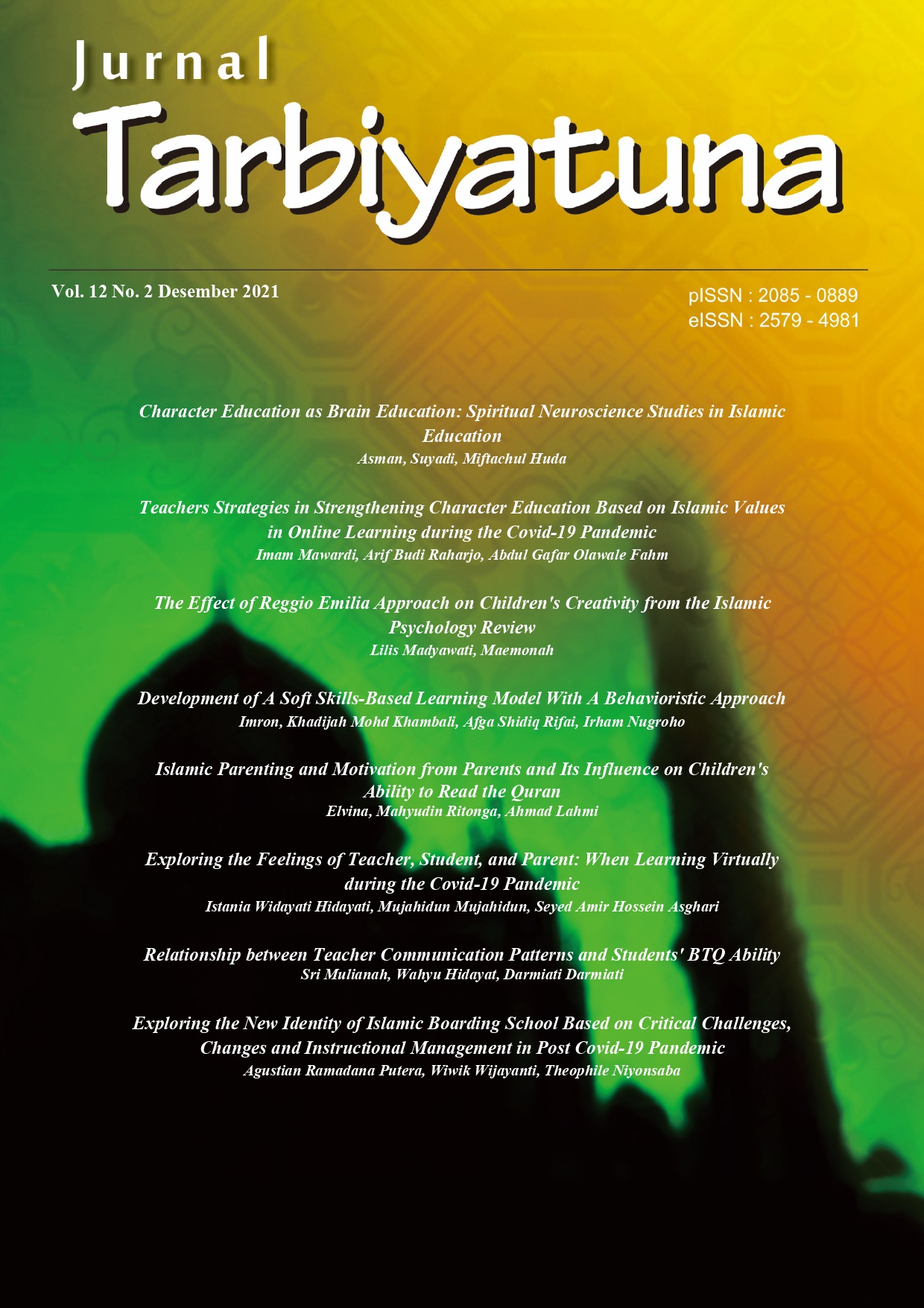Main Article Content
Abstract
Poor communication patterns between teachers and students in learning to read and write the Qur'an or Baca Tulis Qur’an (BTQ) negatively impact students' ability to understand the message conveyed. Therefore, this research aims to determine the relationship or correlation between teacher communication patterns and BTQ ability of junior high school students. This is a quantitative associative research with the random sampling technique used to determine the sample size of 300 students. Data were collected through questionnaires and documentation, while descriptive and inferential methods using the product-moment correlation formula were utilized for analysis. The results indicate that (1) 270 students (90%) out of 300 communicated effectively with teachers, therefore, the communication patterns relationship between them is in the good category. (2) 210 students (70.0%) have BTQ ability in Islamic education, therefore, their ability to read and write is in the good category. (3) there is a positive relationship between teacher communication patterns and students' BTQ ability with 80.1% and 19% in Islamic education and other variables not observed in this research
Keywords
Article Details

This work is licensed under a Creative Commons Attribution-NonCommercial 4.0 International License.
References
- Arquero, J. L., Fernández-Polvillo, C., Hassall, T., & Joyce, J. (2017). Relationships between communication apprehension, ambiguity tolerance and learning styles in accounting students. Revista de Contabilidad-Spanish Accounting Review, 20(1), 13–24. htt
- Bucata, G., & Rizescu, A. M. (2017). The role of communication in enhancing ˘work effectiveness of an organization. Land Forces Academy Review, 22(1), 49–57. https://doi.org/https://doi.org/10.1515/raft- 2017-0008.
- Chetty, R., Friedman, J. N., & Rockoff, J. E. (2014). Measuring the impacts of teachers II: Teacher value-added and student outcomes in adulthood. American Economic Review, 104(9), 2633–2679. https://doi.org/https://doi.org/10.1257/aer.104.9.2633
- Damayanti, A., Suprihatini, T., & Pradekso, T. (2013). Pengaruh Komunikasi Persuasif Guru Dan Motivasi Belajar Siswa Terhadap Prestasi Siswa Pada Mata Pelajaran Bahasa Jawa. Interaksi Online, 2(2).
- Darmadi, D. (2015). Hubungan Komunikasi Guru Terhadap Prestasi Belajar Siswa Pada Mata Pelajaran Sosiologi dI SMU Negeri 5 Samarinda. eJournal Ilmu Komunikas, 3(3), 211–225.
- Dhillon, N., & Kaur, G. (2021). Self-Assessment of Teachers’ Communication Style and Its Impact on Their Communication Effectiveness: A Study of Indian Higher Educational Institutions. SAGE Open, 11(2). https://doi.org/10.1177/21582440211023173.
- Djamarah, S. . (2002). Psikologi belajar. Rineka Cipta.
- Fowler, F. J., Lepkowski, J. M., Tourangeau, R., Wilks, S., Groves, E. R. M., Kalton, G., Rao, N. K., Schwarz, N., & Skinner, C. (2014). Survey Methodology Established in part by WALTER.
- Gage, N. A., Scott, T., Hirn, R., & Macsuga-Gage, A. S. (2018). The relationship between teachers’ implementation of classroom management practices and student behavior in elementary school. Behavioral Disorders, 43(2), 302–315. https://doi.org/10.1177/01
- Heinich, R., Molenda, M., Russel, J. D., & Smaldino, S. E. (2002). teaching reading Today’s In Elementary Schools (7th ed.). Pearson.
- Iriantara, Y. (2014). Komunikasi Pembelajaran Interaksi Komunikatif dan Edukatif di Dalam Kelas (1st ed.). Simbiosa Rekatama Media.
- Lovlyn, E. (2017). The role of effective communication in strategic management of organizations. International Journal of Humanities and Social Science, 6(12), 93–99.
- Malik, A. (2014). Fungsi Komunikasi Antara Guru dan Siswa dalam Meningkatkan Kualitas Pendidikan (Studi Kasus Proses Belajar Mengajar pada SMP Negeri 3 Sindue). INTERAKSI: Jurnal Ilmu Komunikasi, 3(2), 168–173. https://doi.org/10.14710/interaksi,3,2,168-1
- Najib, M. (2017). Komunikasi dan Teknologi Informasi Pendidikan Filosofi, Konsep, dan Aplikasi. CV Pustaka Setia.
- Nasor, M. (2014). Teknik Komunikasi Guru Dan Siswa Dalam Peningkatan Prestasi Siswa. Ijtimaiyya, 7(1).
- Negassa, T., & Engdasew, Z. (2017). The impacts and challenges of pedagogical skills improvement program at Adama Science and Technology University. International Journal of Instruction, 10(4), 19–38. https://doi.org/10.12973/iji.2017.1042a.
- Pallant, J. (2011). Checking the reliability of a scale. In SPSS Survival Manual (4th ed.). Allen & Unwin. https://doi.org/10.4324/9781003117452-12.
- Sabiq, A. F., Cakmin, A., & Hidayah, N. (2020). Implementattion of Tahfizhul Qura’an Learning with Al-Qosimi Method. Tarbiyatuna, 11(2), 143–152.
- Sahabuddin, C. (2015). Hubungan Komunikasi Belajar Mengajar Terhadap Hasil Belajar Peserta Didik di Sekolah Menengah Kejuruan Negeri I Kabupaten Majene. Jurnal Pepatuzdu, 10(1), 17–30.
- Sidelinger, R. J., Frisby, B. N., & Heisler, J. (2016). Students’ out of the classroom communication with instructors and campus services: Exploring social integration and academic involvement. Learning and Individual Differences, 47, 167–171. https://doi
- Sondakh, R., Boham, A., & Harilama, S. H. (2017). Pola Komunikasi Guru Dalam Proses Belajar Anak Down Sindrom di Yayasan Anak Cacat Malalayang. E-Journal Acta Diurna, VI(1).
- Suliswiyadi, S. (2020). Hierarki Ranah Pembelajaran Afektif Pendidikan Agama Islam dalam Perspektif Taksonomi Qur’ani. Jurnal Tarbiyatuna, 11(1), 61–76. https://doi.org/10.31603/tarbiyatuna.v11i1.3451.
- Suprapto, H. A. (2017). Pengaruh Komunikasi Efektif untuk Meningkatkan Hasil Belajar Kewirausahaan Mahasiswa. KHAZANAH PENDIDIKAN, IX(1), 13–24. https://doi.org/10.31849/lectura.v9i1.913.
- Suriadi, S., Supriyatno, T., & Adnan, A. (2020). Al-Qur’an Hadits Learning Using Cooperative Learning Strategy. Jurnal Tarbiyatuna, 11(2), 153–160. http://journal.ummgl.ac.id/index.php/tarbiyatuna/article/view/2750.
